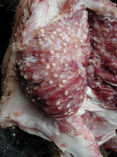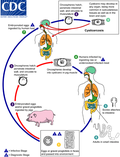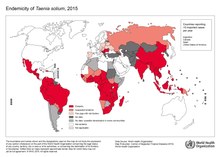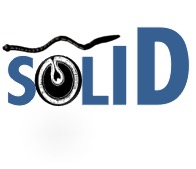Taenia solium in endemic areas
Introduction
Taenia solium taeniasis/cysticercosis is a zoonotic parasitic disease complex ranked first on the FAO/WHO list of foodborne parasitic infections (FAO/WHO, 2014) and fourth on the 31 investigated foodborne hazards described in a recent report on the WHO Global Estimates and Regional Comparisons of the Burden of Foodborne Disease in 2010 (Havelaar et al., 2015).
The normal life cycle entails a human final host with the adult tapeworm (taeniasis) and a pig intermediate host with the metacestode larval stage (cysticercosis). People get infected by the consumption of undercooked infected pork. Pigs get infected by the consumption of infected human stool with tapeworm eggs/proglottids. Unfortunately, people can also act as dead end intermediate host, after ingestion of tapeworm eggs via fecal-oral contamination, whereby the larval stages have a tendency to settle in the human central nervous system (Murrell, 2005). The latter condition, neurocysticercosis (NCC) is responsible of about 30% of acquired epilepsy cases in endemic areas (Ndimubanzi et al., 2010).
Taenia solium in endemic areas
The parasite occurs primarily in developing countries, where conditions of poverty, low sanitation and free-range pig keeping prevail, and meat inspection is mostly absent. Prevalence of active cysticercosis infection of 20% in humans and over 60% in pigs have been described (Coral-Almeida et al., 2015). CT scan studies in highly endemic areas estimated that over half of the acquired epilepsy cases in those areas were due to NCC, indicating the urgent need for control (Mwape et al., 2015).
Ongoing projects
- CYSTISTOP: "Elimination or control, what is the best way forward for Sub Saharan Africa?"
This project is a large-scale intervention study in Zambia which assesses whether elimination of Taenia solium is possible under Sub Saharan Africa (SSA) conditions and what the most cost efficient solution for SSA would be, control or elimination.
Funding:
Institute of Tropical Medicine, Antwerp (SOFI) and GALVMED
Partners:
Belgium: Institute of Tropical Medicine, Antwerp (P. Dorny, E. Bottieau, D. Berkvens, S. Thys, P. Lefèvre); Ghent University, Faculty of Veterinary Medicine (S. Gabriël, I. Van Damme); Université catholique de Louvain, Faculty of Public Health (N. Speybroeck); Scientific Institute of Public Health (B. Devleesschauwer).
Zambia: University of Zambia, School of Veterinary Medicine (K.E. Mwape, I.K. Phiri); Zambian Ministry of Health (G. Zulu)
St Kitts and Nevis: Ross University School of Veterinary Medicine (A.L. Willingham)
Students: E.C Hobbs (Ross University School of Veterinary Medicine-Ghent University-Institute of Tropical Medicine), C. Mwelwa (University of Zambia)
- SOLID: "Evaluation of an antibody detecting point-of-care test for the diagnosis of Taenia solium taeniasis and (neuro)cysticercosis in communities and primary care settings of highly endemic, resource-poor areas in sub Saharan Africa, including capacity building."
The main objective of this project is to contribute to the implementation of a rapid, cheap and simple point of care (POC) test for the detection of T. solium taeniasis and (neuro)cysticercosis in two resource-poor, highly endemic areas in sub-Saharan Africa. The project will field validate the CDC POC test, in Tanzania and Zambia, at the community and primary health facility levels. The project also aims to improve the T. solium disease recognition, diagnostic and clinical case management capacities of these countries as well as their capacity to conduct diagnostic and clinical studies.
Funding:
EDCTP (European and Developing Countries Clinical Trials Partnership), BMBF (German Federal Ministry of Education and Research)
Partners:
Belgium: Institute of Tropical Medicine, Antwerp (P. Dorny, E. Bottieau, V. Dermauw); Ghent University, Faculty of Veterinary Medicine (S. Gabriël, I. Van Damme), Faculty of Sciences (E. Abatih)
Germany: Department of Neurology, Technical University of Munich (V. Schmidt, A. Winkler)
Denmark: Faculty of Health and Medical Sciences, University of Copenhagen (M. Vang Johansen & P. Magnussen); Statens Serum Institut (R. Stensvold)
Tanzania: National Institute for Medical Research, Muhimbili Medical Research Centre (B. Ngowi); Ministry of Health (B. Ndawi); Sokoine University (H. Ngowi)
Zambia: School of Veterinary Medicine, University of Zambia (E.K. Mwape, I.K. Phiri); University Teaching Hospital (C. Chabala, O. Ciccone); Ministry of Health (G. Zulu)
Website:
- COST ACTION TD1302 CYSTINET
Taenia solium (pork tapeworm) and T. saginata (beef tapeworm) cysticercosis (CC)/taeniosis are zoonoses of public health importance, with significant economic impacts on the health and meat (pork and beef) sectors within and outside the EU. The main objective of this Action is to build a strong, extensive, multi-disciplinary scientific network to induce sustainable collaborations with the aim to advance knowledge and understanding of these zoonotic disease complexes. Specific objectives include the development of innovative diagnostic and cost-efficient control tools, assessments of disease burden and economic impact, as well as the development of harmonized reporting and management procedures. Intra-European collaboration is essential to stop the development of these diseases within the EU.
Funding:
COST
Partners:
36 countries/organisations, see: https://www.cost.eu/actions/TD1302/#tabs+Name:Parties
Also: www.cystinet.org
- NEUROSOLVE
Neurocysticercosis (NCC) is a life-threatening disease that causes severe damage to the central nervous system, with epileptic seizures as the primary symptom. The EU-funded (EDCTP3JU) NeuroSolve project aims to improve management of the disease in endemic regions of Tanzania and Zambia. The project will provide training to early-career researchers and healthcare workers, upgrade surveillance infrastructure, demonstrate the (cost-)effectiveness of combined treatment (praziquantel + albendazole) and of serological diagnosis, and provide recommendations for policymakers. A substantial part of the project is focused on implementation science, to effectively implement evidence-based findings in daily clinical practice and life.
Funding:
Global Health EDCTP3 Joint Undertaking (HORIZON-JU-GH-EDCTP3-2022-01)
Partners:
University of Dar es Salaam (Coordinator) (Tanzania), Sokoine University of Agriculture (Tanzania), University of Zambia (Zambia), Universiteit Ghent (Belgium), Revolution Worldwide Srl – Impresa Sociale (Italy)
- 3SI-CONTROL
The EU-funded (EDCTP3JU) 3SI-CONTROL project is a 4-year during project aiming at integrated control of three highly neglected tropical diseases in Sub-Saharan Africa: Taenia solium cysticercosis/taeniasis, soil-transmitted helminthiasis (STH) and schistosomiasis (SCH). Control of STH and SCH has been part of stand-alone routine programs for many years, yet the efficacy and effectiveness of these programs is challenged by low and failing drug efficacy calling for a revision of the MDA-drug strategies. For T. solium the situation is very different from STH and SCH as currently there are no countries routinely implementing control. Based on these critical gaps in the control of T. solium, STH and SCH, the main objective of the 3SI-CONTROL project is to evaluate the safety and effectiveness of simultaneous administration of a new fixed-dose combination of albendazole-ivermectin and praziquantel in sub-Saharan African conditions, where T. solium, STH and SCH are co-endemic, and to develop implementation strategies to ensure uptake.
Funding:
Global Health EDCTP3 Joint Undertaking (HORIZON-JU-GH-EDCTP3-2024-01-03)
Partners:
Universiteit Gent (Coordinator) (Belgium), University of Zambia (Zambia), University of Dar es Salaam (Tanzania), Sokoine University of Agriculture (Tanzania), Institute for Global Health Barcelona (Spain), Hospital Clinic de Barcelona (Spain) and Fundacao Manhiça (Mozambique)
- CENTD
The Consortium of Experts in Neglected Tropical Diseases (CENTD) is an international partnership founded by Ghent University, uniting global experts in tackling the challenges of Neglected Tropical Diseases (NTD). The focus lies on key NTDs, including echinococcosis, schistosomiasis, soil-transmitted helminths (including strongyloidiasis), and taeniasis/cysticercosis. The consortium aims to combat the following challenges: lack of quantitative health risk analysis, poor drug efficacy and quality, lack of point-of-care diagnostics, low intervention coverage, and limited translation of evidence-based knowledge into practice. Through strong research - including multicentric studies, researcher mobility, and expert webinars - CENTD builds capacity and fosters innovation. Stimulating educational initiatives, such as summer schools, and accommodating services support the implementation of sustainable, evidence-based solutions in the fight against NTDs.













